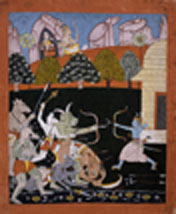
School: Boston College High School
Project Title: Ashrama, Dharma, Moksha: The Ramayana as a Metanarrative for Hindu Cosmology
|
Hinduism explains the social dimension of existence with the Sanskrit term “ashrama” which entails the four stages of life. For Hindus, time and place figure importantly. The first stage is that of a student where the goal is to acquire knowledge and build moral character; the second stage is that of a householder which begins with marriage and recognizes service to family and the deities; the third stage begins when one’s children become adults and an individual enters the ascetic stage by withdrawing from society and begins to focus on meditation and the reading of scriptures; and the final stage is that of a “sannyasin” where one renounces the materialism of the world.
In the Ramayana, the question of identity is continually present in the foreground. The hierarchy of caste enables one to recognize duty and obligation as a family member or friend. Questions of gender often follow from this, especially in terms of a woman’s place (e.g., is it oppressive to say a woman’s place in life is to be the caretaker of the family?) Rama is a member of the Kshatriya class which comprises of warriors and regal administrators; his identity is established as prince of Ayodhya.
|
This site was created by Patrick Tiernan at the NEH Summer Institute "Cultures and Religions of the Himalayan Region," held at the College of the Holy Cross, Summer 2006

